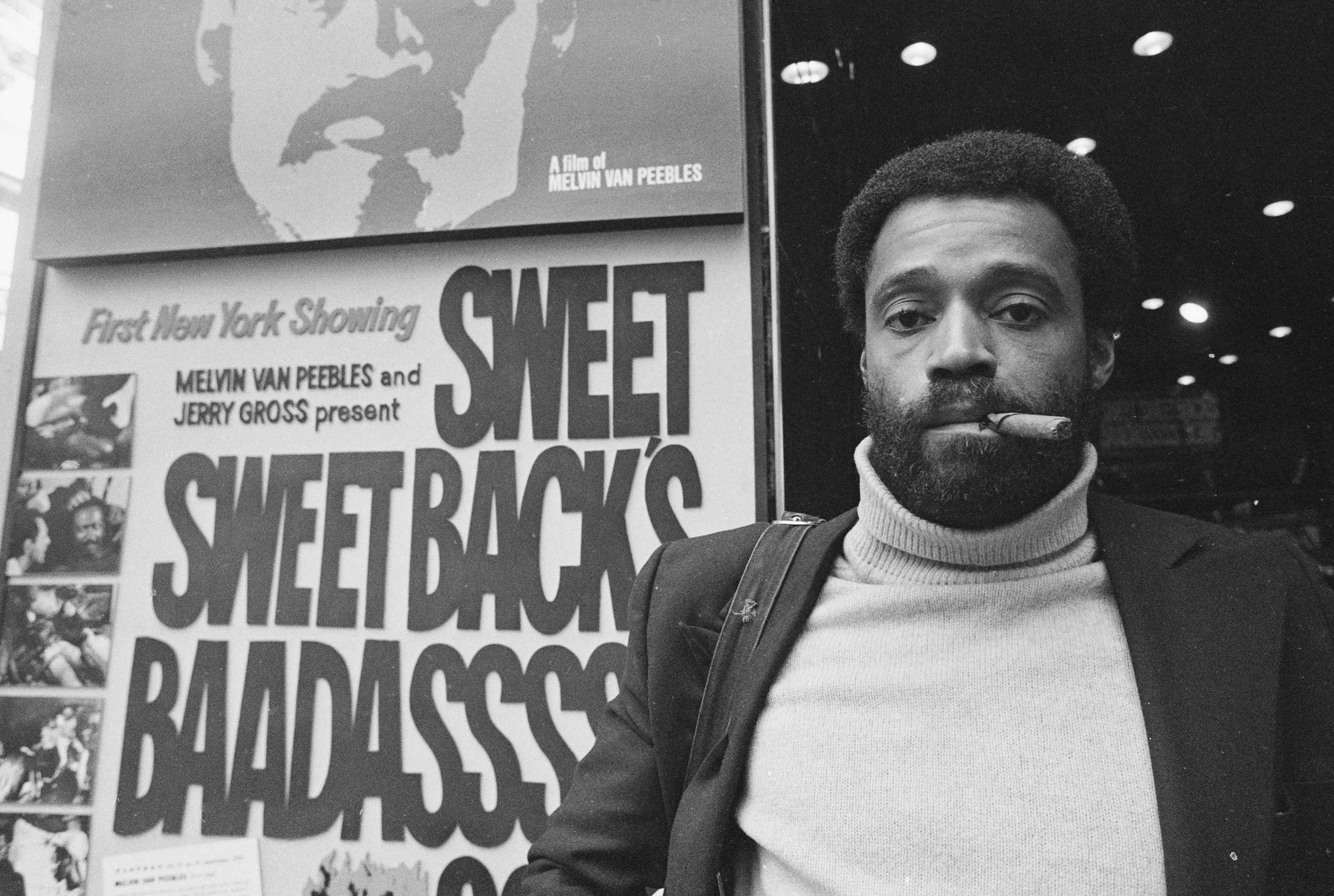 |
| Melvin Van Peebles, 1971. Photo by Pix/Michael Ochs Archives/Getty Images |
The Academy Museum of Motion Pictures' second big temporary exhibition opens Aug. 21. "Regeneration: Black Cinema, 1898–1971" is a deeply serious though accessible survey evoking the shows MOCA once did, excavating new history from movements that turn out to be utterly relevant to the present moment. Curated by AMMP's Doris Berger and the Smithsonian National Portrait Gallery's Rhea L. Comber, "Regeneration" sprawls over 11,000 sf on the museum's fourth floor. This is the space that formerly held "Hayao Miyazaki" (and will feature a John Waters retrospective next year). "Regeneration" is further proof that the Miracle Mile Deathstar isn't just a shrine to movies that win Oscars.
 |
| Installation view with clip of Carmen Jones (1954). Photo by Joshua White, JW Pictures. (c) Academy Museum Foundation |
 |
| Something Good—Negro Kiss (1898) and Glenn Ligon's Double America 2, 2014. Photo by Joshua White, JW Pictures. (c) Academy Museum Foundation |
The exhibition brackets a history spanning a recently rediscovered silent short, Something Good—Negro Kiss (1898) and the blaxploitation classic Sweet Sweetback's Baadassss Song (1971). The former plays in the entry gallery. In 20-some seconds vaudevillians Saint Suttle and Gertie Brown meet cute and make a public display of affection. The film was already a parody, referencing Edison's Kiss, with a white couple. Oddly enough, two copies of Something Good are known, from USC and Norway, and they differ in the positions of the two leads.
The doubling is echoed in Glenn Ligon's Double America 2. It's one of a group of contemporary artworks incorporated through the show. These works (which postdate the 1971 terminus of the film objects) at times seem tacked on. The most directly relevant is a Gary Simmons' Balcony Seating Only, based on a period photo of the entrance to a segregated theater.
 |
| Gary Simmons, Balcony Seating Only, 2017. Photo by Joshua White, JW Pictures. (c) Academy Museum Foundation |
 |
| Kara Walker, The End of Uncle Tom and the Grand Allegorical Tableau of Eva in Heaven, 1995. Photo by Joshua White, JW Pictures. (c) Academy Museum Foundation |
A Kara Walker, The End of Uncle Tom and the Grand Allegorical Tableau of Eva in Heaven, was lent by Jeffrey Deitch, no less.
 |
| Race film posters and camera. Photo by Joshua White, JW Pictures. (c) Academy Museum Foundation |
Many "race films" (created by Black filmmakers for segregated Black audiences) survive only in the form of posters and lobby cards. There are some rare clips in the galleries, and the exhibition has an accompanying film program with several new discoveries. One is
Reform School (1939), starring Louise Beavers.
The camera here is from the Norman Film Company, a studio based in Jacksonville, Fla. It produced Regeneration, the 1923 film that supplies the exhibition's title. Black castaways find themselves on a desert island, discover buried treasure, and are rescued. Norman Film advised exhibitors to promote the film by filling their lobbies with sand. Jacksonville's film industry was known for corner-cutting (pulling fire alarms to film fire trucks for free). This led to a backlash against the Jacksonville movie industry and to Norman's demise.
 |
| Music and film gallery. Photo by Joshua White, JW Pictures. (c) Academy Museum Foundation |
 |
| Mills Panoram movie jukebox, about 1939 |
Installed in bars and cafes, movie jukeboxes played short music videos ("soundies"). The medium was important to Fats Waller, Cab Calloway, Dorothy Dandridge, and Louis Armstrong. In the 1940s Hollywood film studios decided soundies were competition and crushed them out of existence.
 |
| Tap shoes of the Nicholas Brothers (Harold and Fayard) |
The jazz age increased the visibility of black musicians and dancers in film. As dancers, the Nicholas brothers were the peers of Fred Astaire and Gene Kelly, but their race excluded them from lead roles in Hollywood.
 |
| Costume designs for Carmen Jones (1954) with poster |
The exhibition ends with the socially conscious films of Melvin van Peebles and Gordon Parks. Van Peebles' Sweet Sweetback's Baadasssss Song is here framed as the point of departure for all that came after. It was revolutionary not only in its politics (praised by Huey Newton) but in its cinematography, with its innovative (and still copied) camera moves and montage techniques.
Spike Lee said: "Sweet Sweetback's Baadasssss Song gave us all the answers we needed. This was an example of how to make a film (a real movie), distribute it yourself, and most important, get paid."
"Regeneration: Black Cinema, 1898–1971" opens this Sunday and runs through Apr. 9, 2023.












Comments
I wonder if Miyazaki would have gotten an early nod if his {insert cultural-political category here] didn't meet the criteria?
Incidentally, the AMPAS museum is on land once occupied by the Tongva indigenous people. Going back even further, it's also on land once occupied by mastodons, saber-tooth tigers and other vertebrates.